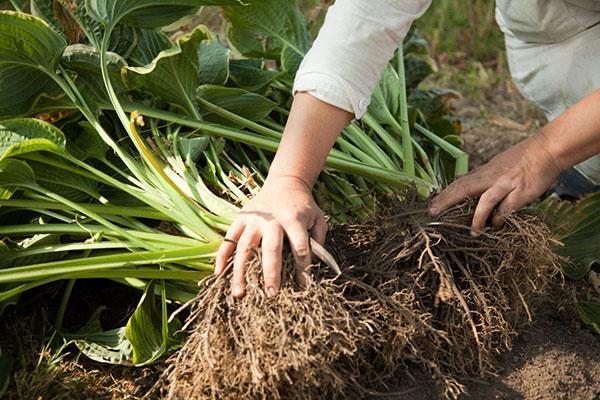Reproduction of hosts in no time
 The end of August is a great time to divide perennial crops. The hosts also breed in the spring. As soon as cone-shaped sprouts hatch from the soil, they are immediately dug out, in whole or in part. Young shoots themselves often suggest how best to divide the bush.
The end of August is a great time to divide perennial crops. The hosts also breed in the spring. As soon as cone-shaped sprouts hatch from the soil, they are immediately dug out, in whole or in part. Young shoots themselves often suggest how best to divide the bush.
If the grower did not manage to carry out the procedure in the spring due to prolonged rains, then it is transferred to the first half of September. In this case, it is worth considering the peculiarities of your climate. Before the onset of frost, the plant will need a month and a half to take root.
Read also the article: hosts - landing and care!
Reproducing hosts in several ways
The first step is to dig a bush together with an earthen lump. They carefully examine it, determining the places in which the division is planned to be carried out. It is worth considering that each individual seedling must have at least two outlets. This will significantly reduce the time of its growth.
Then, using a garden shovel, cut the bush. If the leaves break, then during the reproduction of hosts this is a completely natural process. They are still cut off at a distance of 10 cm from the basal neck. Excess soil is shaken off the roots, and sprouted weeds are also removed.
Due to the fact that the foliage is removed, it will still have time to grow in the several warm months of autumn. At the same time, the roots can quickly take root in a new place.
Stage two - landing
The hole is made twice as large as the seedling rhizome. It is worth remembering that the hosta loves slightly acidic soil, so a little is added to the soil peat... They use both a garden substrate and a purchased one.
Also, the culture needs good drainage, otherwise it will develop poorly. When planting, several nuances are observed:
- the root system is straightened;
- the basal neck is moderately buried;
- cover the planting circle with mulch or peat;
- compact the earth;
- water the seedling abundantly so that voids do not form inside.
In this state, the plant will go to winter, and in the spring it will surprise the grower with luxurious foliage. There is another method for propagating hosts. It is relevant when there is no way to dig up the entire bush. It does not matter whether it is big or small. Again they are looking for a border for cutting. A shovel is inserted into the middle of the plant and the rhizome is dug out together with the ground. The mother culture is left unchanged, and the daughter culture is cut off. Now she needs systematic watering before the cold season begins.
The cut is treated with ash so that it does not start to rot, and the hole is filled with nutritious soil.
Since the hosta is an unpretentious plant, it successfully tolerates the division of the bush with any of the proposed options. Nevertheless, if the site was not conscientiously mulched, then in the spring it is recommended to apply nitrogen-containing fertilizers.